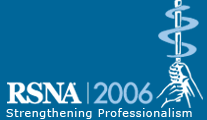
Abstract Archives of the RSNA, 2006
SST17-03
Defining the Normal Range of Anatomical Anterior Vertebral Body "Wedging" at the Thoraco-Lumbar Junction
Scientific Papers
Presented on December 1, 2006
Presented as part of SST17: Musculoskeletal (Spine, Disk Disease)
Michael Crawford MBChB, Presenter: Nothing to Disclose
Andoni Paul Toms MBBS, Abstract Co-Author: Nothing to Disclose
Lee Shepstone PhD, Abstract Co-Author: Nothing to Disclose
Vinod Shenoy MBBS, Abstract Co-Author: Nothing to Disclose
The purpose of this study is to define the normal range of angulation of the endplates of the T12 and L1 vertebral bodies using measures that can easily be applied to routine reporting of lumbar spine radiographs on PACS.
A retrospective analysis of lateral scout tomographs from 200 consecutive thoraco-abdominal CTs was performed.
Exclusion criteria were as follows: major trauma (such as RTA) as an indication for the CT, any disease of the vertebral column, spinal canal, para-vertebral soft tissues or retro-peritoneum, traumatic vertebral fractures, known vertebral collapse.
End plate angles were measured from the lateral tomographs. The superior endplate was defined as a line drawn between the most anterio-superior and the most postero-superior corner of the vertebral body. The inferior endplate angle was similarly defined for the anterior and posterior inferior corners. The angle between the two endplates was measured using the Cobb angle tool on the PACS workstation.
100 patients were reported independently by two observers. 50 patients were reported twice by the same observer with an interval of 8 weeks.
The mean end plate angle, with a normal range defined as two standard deviations, was calculated for T12 and L1. Intra and inter-observer reliability was quantified using correlation coefficients with 95% confidence intervals.
The mean endplate angle for T12 was 4.8 degrees with a normal range of 0 to 9.6 (SD=2.4). The mean endplate angle for L1 was 4.7 degrees with a normal range of -0.1 to 9.5 (SD=2.4).
The intra-class correlation coefficient for intra-observer reliability was 0.800 for T12 (95% CI : 0.674 , 0.926) for T12 and 0.794 (95% CI : 0.665 , 0.923). For inter-observer reliability the ICC was 0.858 (95% CI : 0.794 , 0.923) for T12 and 0.808 (95% CI : 0.723 , 0.893) for L1.
The normal range of anatomical vertebral wedging at T12 and L1, demonstrated with a high level of reliability, is approximately 0 to 10 degrees.
T12 or L1 vertebral endplate angulation of over 10 degrees, which is easily measured with standard DICOM browser tools, is outside the normal range.
Crawford, M,
Toms, A,
Shepstone, L,
Shenoy, V,
Defining the Normal Range of Anatomical Anterior Vertebral Body "Wedging" at the Thoraco-Lumbar Junction. Radiological Society of North America 2006 Scientific Assembly and Annual Meeting, November 26 - December 1, 2006 ,Chicago IL.
http://archive.rsna.org/2006/4429566.html

